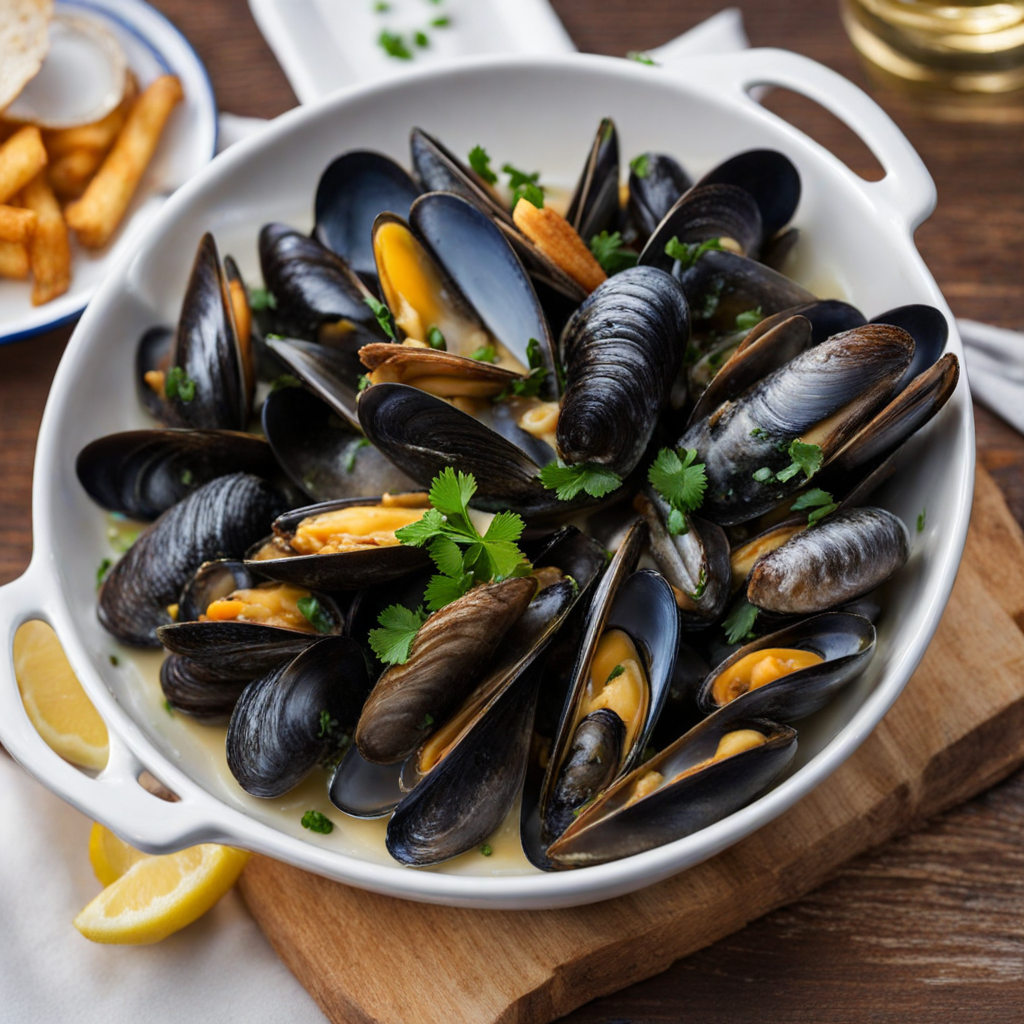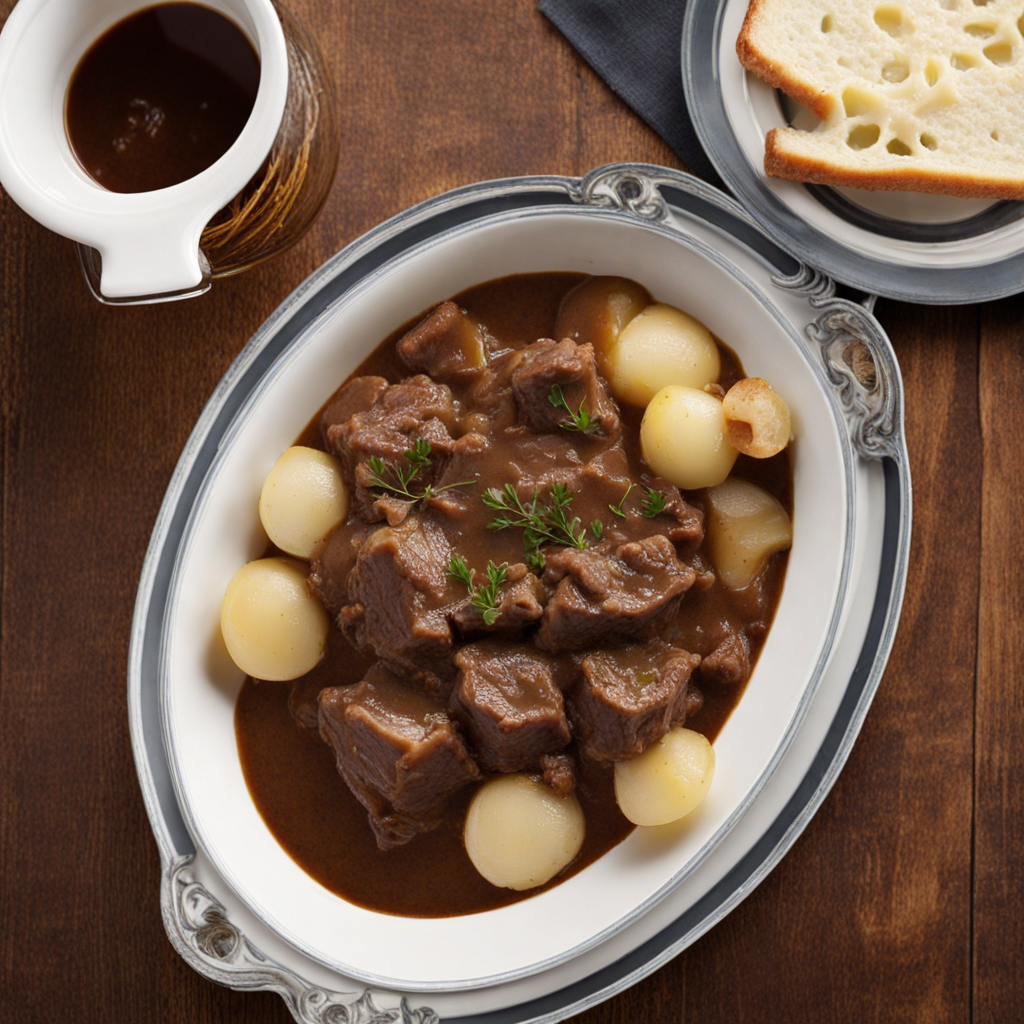Moules-frites
Moules-frites, a beloved dish hailing from Belgium, showcases the delightful pairing of mussels and fries, encapsulating the essence of Belgian comfort food. The mussels are typically steamed in a variety of flavorful broths, often featuring white wine, shallots, garlic, and herbs. This simple yet elegant preparation allows the natural sweetness of the mussels to shine through, while the aromatic broth infuses each bite with a taste of the sea. Diners are often presented with a large pot brimming with plump, tender mussels, their shells glistening and slightly ajar, inviting you to indulge in this culinary experience. Complementing the mussels are the fries, or "frites," which are a staple of Belgian cuisine. These fries are known for their perfect golden crispiness on the outside and fluffy softness on the inside, usually double-fried to achieve that ideal texture. Served in paper cones or on a plate, the frites are often accompanied by a variety of dipping sauces, with mayonnaise being the most traditional choice. The contrast between the rich, savory mussels and the crispy, salty fries creates a delightful harmony of flavors and textures that makes moules-frites an irresistible dish. Enjoying moules-frites is not just about the food itself; it’s an experience that embodies the convivial spirit of Belgian dining. Typically enjoyed in a casual setting, this dish is perfect for sharing with friends over a pint of Belgian beer, as the effervescence of the brew complements the briny taste of the mussels beautifully. The communal aspect of digging into a pot of mussels and passing around the fries enhances the joy of the meal, making it a quintessential choice for those looking to explore authentic Belgian cuisine.
How It Became This Dish
The History of Moules-Frites: A Belgian Culinary Treasure Moules-frites, a dish synonymous with Belgian cuisine, captures the essence of simplicity and comfort in its combination of mussels and fries. This culinary delight has roots that intertwine with the cultural and geographical landscape of Belgium, making it not just a meal but a reflection of the country's heritage. #### Origins: A Maritime Heritage The history of moules-frites can be traced back to the coastal regions of Belgium, where mussels have been harvested from the North Sea for centuries. The abundance of mussels in Belgian waters made them a staple for local communities, particularly in port towns like Ostend and Nieuwpoort. The practice of gathering shellfish dates back to prehistoric times, with archaeological evidence suggesting that both mussels and oysters were consumed by the early inhabitants of the region. Frites, or fries, are believed to have originated in Belgium as well. The story goes that in the late 1600s, villagers around the Meuse River would fry small fish as a source of sustenance during the winter months. When the river froze, they resorted to frying potatoes cut in the shape of fish to continue their tradition. The two components of moules-frites have thus been historically linked through the culinary practices of the Belgian people. #### Cultural Significance: A National Dish Moules-frites is more than just a meal; it is a national symbol of Belgian identity. The pairing of mussels and fries has become a beloved dish that reflects the country’s rich gastronomic culture. Traditionally served in a large pot, moules-frites is often enjoyed in convivial settings, where friends and family gather to share stories over steaming mussels and crispy fries. The significance of moules-frites extends beyond the dining table. It represents the communal spirit of Belgium, embodying the country’s emphasis on shared experiences and local ingredients. In many Belgian towns, especially during the summer months, outdoor markets and festivals celebrate this dish, drawing locals and tourists alike. The act of enjoying moules-frites is often accompanied by a glass of Belgian beer, further enhancing the cultural experience. #### Development Over Time: From Humble Beginnings to Culinary Icon As Belgium entered the 19th and 20th centuries, moules-frites began to gain prominence beyond its humble origins. The industrial revolution, coupled with urbanization, led to a rise in restaurants and cafes, where moules-frites became a staple on menus. The dish epitomized the working-class ethos; it was affordable, hearty, and easily shared among patrons. In the post-World War II era, moules-frites underwent a renaissance. As travel became more accessible, Belgium’s culinary scene began to attract international attention. Chefs started experimenting with different preparations of mussels, incorporating various regional ingredients and flavors. Classic preparations included moules marinières, cooked with white wine, shallots, and parsley, while others embraced local brews or cream-based sauces. By the late 20th century, moules-frites had solidified its position as a must-try dish for visitors to Belgium. Its popularity expanded beyond the borders of the country, influencing culinary scenes in neighboring regions and even across the Atlantic in places like France and the United States. Belgian-style brasseries began to pop up in major cities, serving moules-frites alongside an array of other Belgian specialties, such as waffles and chocolate. #### Modern Interpretations: Culinary Innovation In contemporary times, moules-frites has seen a wave of innovation as chefs experiment with new flavors and cooking techniques. While traditional recipes remain beloved, modern interpretations often incorporate global influences. For instance, some chefs have introduced Asian-inspired ingredients, such as lemongrass and ginger, to enhance the flavor profile of the mussels. Others have embraced the trend of sustainable seafood, sourcing mussels from certified fisheries to promote environmental responsibility. In addition, the rise of the gourmet food movement has led to a focus on quality and presentation. Upscale restaurants now serve moules-frites with artisanal fries, often cooked in duck fat or served with gourmet dipping sauces. This evolution reflects a broader trend in gastronomy, where traditional dishes are reimagined to appeal to contemporary palates while preserving their cultural roots. #### A Global Legacy Today, moules-frites is celebrated not just in Belgium but around the world. Its status as a culinary icon is recognized in international food festivals, where chefs showcase their unique takes on the dish. Belgian expatriates and food enthusiasts alike have championed moules-frites, ensuring its place on menus far beyond its homeland. Moreover, moules-frites embodies the concept of ‘terroir’—the connection between food and the place it comes from. The dish highlights the importance of local ingredients and the cultural practices surrounding them. As climate change and sustainability become pressing issues, the emphasis on local sourcing and responsible fishing practices is increasingly relevant, ensuring that moules-frites will continue to evolve while respecting its origins. #### Conclusion: A Timeless Delight Moules-frites stands as a testament to Belgium’s rich culinary heritage, reflecting the country’s history, culture, and communal spirit. From its origins as a humble dish among coastal communities to its status as a beloved national symbol, moules-frites captures the heart of Belgian cuisine. As it continues to evolve through innovation and globalization, this dish remains a timeless delight that invites all to savor the flavors and stories of Belgium. Whether enjoyed in a bustling brasserie or a seaside café, moules-frites is more than just food; it is a celebration of life’s simple pleasures, shared among friends and family.
You may like
Discover local flavors from Belgium







